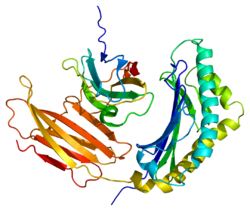Prolactin Induced Protein
| Prolactin Induced Protein | ||
|---|---|---|

|
||
| Properties of human protein | ||
| Mass / length primary structure | 16.6 kilodaltons / 146 amino acids | |
| Secondary to quaternary structure | Monomer | |
| Identifier | ||
| Gene names | PIP GCDFP-15; GCDFP15; GPIP4 | |
| External IDs | ||
| Occurrence | ||
| Homology family | PIP | |
| Parent taxon | Higher mammals | |
| Orthologue | ||
| human | House mouse | |
| Entrez | 5304 | 18716 |
| Ensemble | ENSG00000159763 | ENSMUSG00000058499 |
| UniProt | P12273 | P02816 |
| Refseq (mRNA) | NM_002652 | NM_008843 |
| Refseq (protein) | NP_002643 | NP_032869 |
| Gene locus | Chr 7: 143.13 - 143.14 Mb | Chr 6: 41.85 - 41.85 Mb |
| PubMed search | 5304 |
18716
|
The prolactin-induced protein (PIP, SABP, GCDFP-15) is a protein that is normally found in the saliva and other body secretions of mammals , but can also be detected in pathological changes in the mammary glands . The binding of PIP to aquaporin-5 in the salivary and lacrimal glands leads to the transport of aquaporin-5 into the apical membrane; a change in this process seems to be partly responsible for Sjogren's syndrome . The ability to bind to the Fc fragment of immunoglobulin G suggests possible immunomodulatory functions for PIP. The protein also has binding sites for actin , and it also binds to zinc-α2-glycoprotein (ZAG); related functions of the protein are not known.
The production of PIP in sperm , salivary , lacrimal and sweat glands is increased by prolactin and androgens , and slowed down by estrogen .
In pathological and neuropathological diagnostics, antibodies directed against GCDFP-15 are used as immunohistochemical diagnostic markers.
Individual evidence
- ↑ a b UniProt P12273
- ↑ Hassan MI, Bilgrami S, Kumar V, et al : Crystal structure of the novel complex formed between zinc alpha2-glycoprotein (ZAG) and prolactin-inducible protein (PIP) from human seminal plasma . In: J. Mol. Biol. . 384, No. 3, December 2008, pp. 663-72. doi : 10.1016 / j.jmb.2008.09.072 . PMID 18930737 .
- ↑ Ohashi Y, Tsuzaka K, Takeuchi T, Sasaki Y, Tsubota K: Altered distribution of aquaporin 5 and its C-terminal binding protein in the lacrimal glands of a mouse model for Sjogren's syndrome . In: Curr. Eye Res. . 33, No. 8, August 2008, pp. 621-9. doi : 10.1080 / 02713680802262819 . PMID 18696337 .
- ↑ Chiu WW, Chamley LW: Human seminal plasma prolactin-inducible protein is an immunoglobulin G-binding protein . In: J. Reprod. Immunol. . 60, No. 2, December 2003, pp. 97-111. PMID 14638438 .
- ↑ Mazoujian et al .: The ultrastructural localization of gross cystic disease fluid protein (GCDFP-15) in breast epithelium. In: Am J Pathol , 1984; 116 (2): 305-10. PMID 6205595
- ↑ Viacava et al .: Spectrum of GCDFP-15 expression in human fetal and adult normal tissues. In: Virchows Arch , 1998; 432 (3): 255-60. PMID 9532005
- ↑ Mazoujian et al .: Immunohistochemistry of a gross cystic disease fluid protein (GCDFP-15) of the breast. A marker of apocrine epithelium and breast carcinomas with apocrine features. At J Pathol. 1983; 110 (2): 105-12. PMID 6130702
